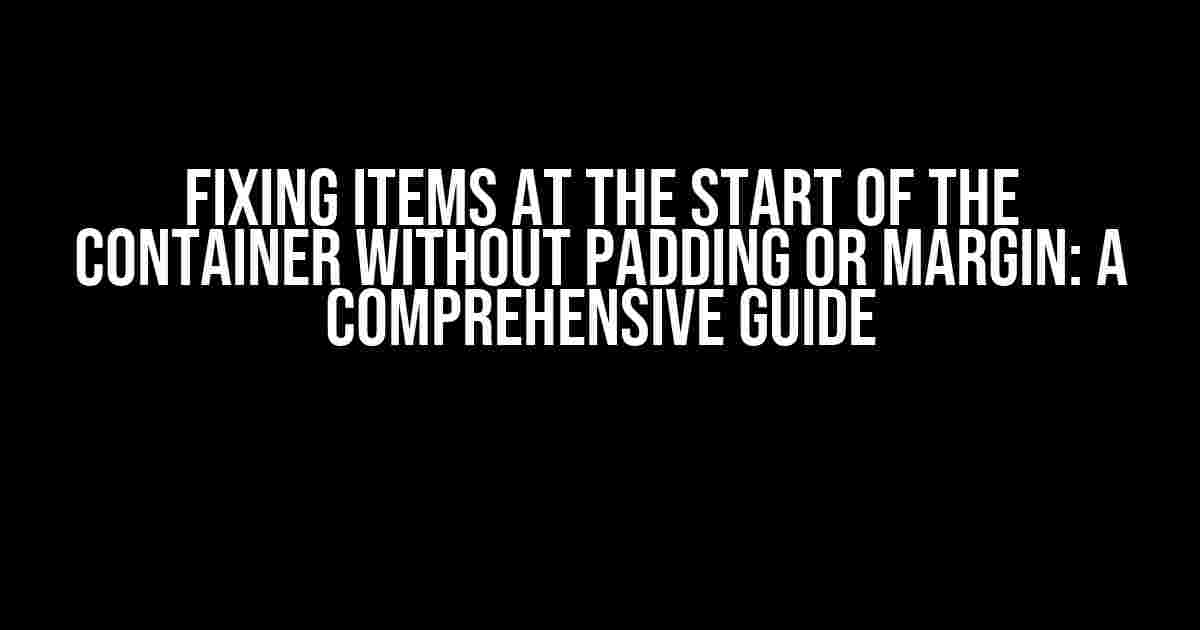Are you tired of dealing with pesky padding and margin issues when trying to fix items at the start of a container? You’re not alone! In this article, we’ll dive into the world of CSS styling and provide you with clear, direct instructions on how to overcome this common problem. So, buckle up and let’s get started!
Understanding the Problem
Before we dive into the solutions, it’s essential to understand the problem at hand. When you try to fix an item at the start of a container using CSS, you might encounter issues with padding and margin. These two properties can add unwanted space between the item and the container’s edge, making it difficult to achieve the desired layout.
Let’s take a look at an example to illustrate this problem:
<div class="container"> <p>This paragraph should be fixed at the start of the container.</p> </div>
And the corresponding CSS:
.container {
background-color: #f0f0f0;
padding: 20px;
}
.container p {
background-color: #ccc;
margin: 10px;
}
As you can see, the paragraph is not fixed at the start of the container due to the padding and margin added to the container and paragraph, respectively.
Solution 1: Using the `box-sizing` Property
One way to fix items at the start of the container without padding or margin is by using the `box-sizing` property. This property allows you to change how the browser calculates the width and height of an element.
Let’s modify our previous example to use `box-sizing`:
.container {
background-color: #f0f0f0;
padding: 20px;
box-sizing: border-box;
}
.container p {
background-color: #ccc;
margin: 0;
}
By setting `box-sizing` to `border-box`, we’re telling the browser to include the padding and border in the element’s width and height calculations. This allows us to fix the paragraph at the start of the container without any issues.
Solution 2: Using a Wrapper Element
Another approach to fixing items at the start of the container is by using a wrapper element. This method involves wrapping the item in a new element and applying the padding or margin to the wrapper instead of the item itself.
Let’s modify our previous example to use a wrapper element:
<div class="container">
<div class="wrapper">
<p>This paragraph should be fixed at the start of the container.</p>
</div>
</div>
And the corresponding CSS:
.container {
background-color: #f0f0f0;
}
.wrapper {
padding: 20px;
}
.wrapper p {
background-color: #ccc;
margin: 0;
}
By applying the padding to the wrapper element instead of the container, we can fix the paragraph at the start of the container without any issues.
Solution 3: Using a Negative Margin
In some cases, you might need to use a negative margin to fix an item at the start of the container. This method involves applying a negative margin to the item that’s equal to the padding or margin of the container.
Let’s modify our previous example to use a negative margin:
.container {
background-color: #f0f0f0;
padding: 20px;
}
.container p {
background-color: #ccc;
margin-left: -20px;
}
By applying a negative margin of `-20px` to the paragraph, we can fix it at the start of the container, effectively negating the padding of the container.
Solution 4: Using Flexbox
Flexbox is a powerful layout mode that allows you to easily fix items at the start of a container. By setting the container to `display: flex` and applying `justify-content: flex-start`, you can fix the item at the start of the container.
Let’s modify our previous example to use Flexbox:
.container {
background-color: #f0f0f0;
display: flex;
justify-content: flex-start;
padding: 20px;
}
.container p {
background-color: #ccc;
margin: 0;
}
By using Flexbox, we can easily fix the paragraph at the start of the container without any issues.
Common Pitfalls and Troubleshooting
When fixing items at the start of a container, you might encounter some common pitfalls and issues. Here are some troubleshooting tips to help you overcome them:
Pitfall 1: Forgetting to Reset Browser Defaults
Browsers often apply default styles to elements, which can affect how your layout renders. Make sure to reset browser defaults by applying `margin: 0` and `padding: 0` to the container and item elements.
Pitfall 2: Not Accounting for Border Width
When using the `box-sizing` property, don’t forget to account for the border width. If you’re applying a border to the container, make sure to include the border width in the padding calculation.
Pitfall 3: Overlooking Element Positioning
When using absolute or relative positioning, make sure to set the `top`, `left`, `right`, and `bottom` properties correctly to avoid any layout issues.
| Solution | Pros | Cons |
|---|---|---|
| Using `box-sizing` | Easiest solution, works well for simple layouts | Can be affected by border width, may not work for complex layouts |
| Using a wrapper element | More flexible than `box-sizing`, works well for complex layouts | Requires additional HTML element, may add complexity to layout |
| Using a negative margin | Quick and easy solution, works well for simple layouts | Can be affected by browser defaults, may not work for complex layouts |
| Using Flexbox | Most flexible solution, works well for complex layouts | Requires good understanding of Flexbox, may not work for older browsers |
Conclusion
Fixing items at the start of a container without padding or margin can be a challenging task, but with the right techniques and approaches, you can achieve the desired layout. Remember to understand the problem, use the right solution for your specific use case, and troubleshoot common pitfalls to ensure a smooth and efficient development process.
By following the instructions and explanations provided in this article, you should be able to fix items at the start of a container like a pro! So, go ahead and give it a try, and remember to stay creative and keep on coding!
Here are 5 Questions and Answers about “fixing items at the start of the container without padding margin” with a creative voice and tone:
Frequently Asked Question
Got a query about keeping those pesky items snug at the start of the container? We’ve got the answers!
Why do my items keep getting pushed away from the edge?
Hey, it’s likely because you’ve got some sneaky padding or margin messing with your layout! Remove those culprits, and your items should snap back into place.
How do I keep my items from having a massive gap between them?
Easy peasy! Just set `margin: 0` on the parent container, and make sure there are no rogue `margin` or `padding` styles affecting your items. Voilà, snug and cozy!
What’s the difference between margin and padding, anyway?
Think of `margin` as the space outside an element, while `padding` is the space inside. So, `margin` affects the gap between elements, and `padding` affects the space between an element’s content and its border.
Can I use CSS Grid to fix this issue?
Absolutely! CSS Grid is a powerful tool for grid-based layouts. You can use `grid-gap` to control the space between grid items, or set `margin` and `padding` to `0` on the grid container and items.
What about Flexbox? Can I use that to fix this issue?
Yep! Flexbox is another great option. Set `margin` and `padding` to `0` on the flex container, and use `justify-content: flex-start` to keep items aligned to the start of the container. Easy fix!


